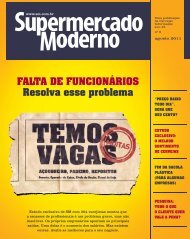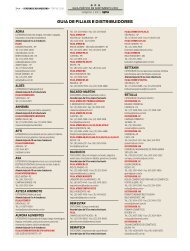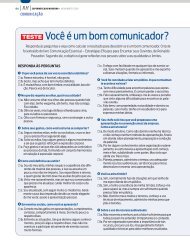1unilever brasil - Supermercado Moderno
1unilever brasil - Supermercado Moderno
1unilever brasil - Supermercado Moderno
You also want an ePaper? Increase the reach of your titles
YUMPU automatically turns print PDFs into web optimized ePapers that Google loves.
Hemp as an Agricultural CommodityIn November 2013, in response to a letter to Representative Earl Blumenauer, DOJ officials inOregon clarified that since “‘industrial hemp’ is marijuana, under the CSA, these eightenforcement priorities apply to hemp just as they do for all forms of cannibis” and that “federalprosecutors will remain aggressive” when it comes to protecting these eight priorities. 70Other Federal ActionsIn 1994, President Clinton issued Executive Order 12919, entitled “National Defense IndustrialResources Preparedness,” which was intended to strengthen the U.S. industrial and technologybase for meeting national defense requirements. The order included hemp among the essentialagricultural products that should be stocked for defense preparedness purposes. 71 Some hempsupporters have argued that the executive order gives hemp a renewed value as a strategic cropfor national security purposes, in line with its role in World War II. 72USDA has supported research on alternative crops and industrial uses of common commoditiessince the late 1930s. Some alternative crops have become established in certain parts of theUnited States—kenaf (for fiber) in Texas, jojoba (for oil) in Arizona and California, and amaranth(for nutritious grain) in the Great Plains states. Many have benefits similar to those ascribed tohemp, but are not complicated by having a psychotropic variety within the same species.The Critical Agricultural Materials Act of 1984 (P.L. 98-284, 7 U.S.C. §178) supports thesupplemental and alternative crops provisions of the 1985 and 1990 omnibus farm acts and otherauthorities, and funds research and development on alternative crops at USDA and statelaboratories. In 2010, USDA recommended $1.083 million for programs under the act. 73 Inaddition, Section 1473D of the National Agricultural Research, Extension, and Teaching PolicyAct of 1977 (NARETPA, 7 U.S.C. §3319d(c)) authorizes USDA to make competitive grantstoward the development of new commercial products derived from natural plant material forindustrial, medical, and agricultural applications. 74 In 2010, USDA recommended $835,000 forthe program. 75 To date, these authorities have not been used to develop hemp cultivation and use.State LawsThe past decade has witnessed a resurgence of interest in the United States in producing industrialhemp. Farmers in regions of the country that are highly dependent upon a single crop, such astobacco or wheat, have shown interest in hemp’s potential as a high-value alternative crop,although the economic studies conducted so far paint a mixed profitability picture.70 Letter to Representative Earl Blumenauer, from S. Amanda Marshall, U.S. Attorney, District of Oregon, November7, 2013.71 Hemp is included under the category of “food resources,” which it defined to mean, in part, “all starches, sugars,vegetable and animal or marine fats and oils, cotton, tobacco, wool, mohair, hemp, flax, fiber and other materials, butnot any such material after it loses its identity as an agricultural commodity or product.”72 J. B. Kahn, “Hemp ... Why Not?” Berkeley Electronic Press (bepress) Legal Series, Paper 1930, 2007.73 USDA’s 2011 Explanatory Notes, http://www.obpa.usda.gov/17nifa2011notes.pdf.74 For information, see USDA, http://www.csrees.usda.gov/funding/rfas/pdfs/10_alt_crops.pdf.75 See USDA’s 2011 Explanatory Notes, http://www.obpa.usda.gov/17nifa2011notes.pdf.Congressional Research Service 18
















